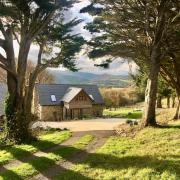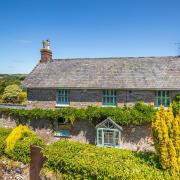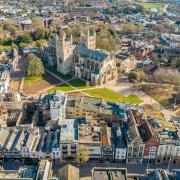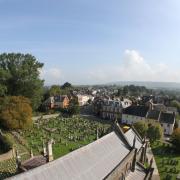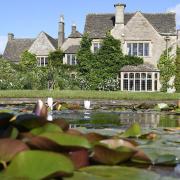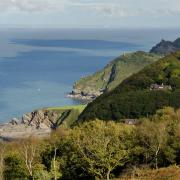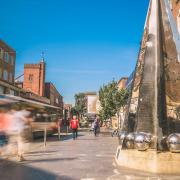Slapton Ley is a unique coastal habitat where a freshwater lake meets the sea. Behind the scenic views, a lot of time and effort goes into preserving this idyllic spot, as CHRISSY HARRIS discovers

Lee Dennison is at hard at work, doing the morning rounds during what will no doubt be another busy day. Maintenance jobs need organising, projects co-ordinating and budgets balancing.
It might be non-stop here at Slapton Ley National Nature Reserve but it is also stunningly beautiful.
A day at the office is by no means a grind when you're stood looking over some of the most incredible scenery in the South Hams.

"It really is such a wonderful place if people take the time to explore," says Lee, regional site manager for the Field Studies Council, the organisation that runs the 214-hectare reserve.
There is also a field studies centre on site, where schoolchildren, university students, academics, community groups and more can come and stay while using the reserve as an 'outdoor laboratory'.
"Listen - can you hear that?" says Lee, as we stand on one of the many viewing platforms dotted around Slapton Ley, the largest natural lake in the South West and a Site of Special Scientific Interest (SSSI).

"It's a Cetti's warbler; you can hear these birds all year round here."
The reserve, separated from the sea by a shingle ridge, is home to a fantastic range of wildlife, flora and fauna rarely seen in anywhere else in the UK.
For instance, it's one of only two only places in Britain where you'll find a tiny plant called strapwort, which grows here on the lakeshore (it's also found in Loe Pool, part of the National Trust's Penrose Estate in Cornwall).

"It likes the shingle here," says Lee as we bend down - and then down even further - to have a look. Turns out, the ground-hugging strapwort is not the most big and fancy of foliage, but beauty comes in all shapes and sizes.
"It thrives on disturbed ground so sometimes the cattle are brought down here to stir up the shingle before the plants start to grow," adds Lee, as we make our way back around the lake and towards Slapton Sands beach.
Lee wants to show me a new bus shelter, apparently. I wonder what this has got to do with the natural beauty of the area until we get up close.

This particular bus shelter was made from a 176-year-old oak tree, which had fallen down in nearby Slapton Woods.
Local tree care and woodwork expert Eddie Church was drafted in to turn the timber into what looks like a work of art, complementing its surroundings perfectly.
"We try to source as many materials as we can from the woodlands and the reserve," says Lee. "We also aim to keep the labour local," he adds, explaining how much of the maintenance work at Slapton Ley is done by teams of local volunteers.

We pass two, just finishing a morning's strimming session before heading up to the Slapton Ley Field Centre for lunch.
"There are always jobs to be done and we rely on our volunteers - they're brilliant," says Lee, adding that it's a fine line between maintaining the reserve and letting nature do its thing.
"There are some invasive species that we need to keep on top of," he says. "We have volunteer 'balsam bashing'days to help us eradicate Himalayan Balsam."

Lee says the landscape here is always changing, thanks to Mother Nature.
In 2018, severe storms washed away the main coastal road, which runs between the sea and the freshwater lake.
For a while, Slapton Ley was pretty cut off until the road was reconstructed and reopened in October, 20 metres further inland.

As part of the rebuild, conservation work at the nature reserve was given a funding boost and a number of projects here have since gone ahead.
A new wetland area next to a diverted stream and a restored viewing platform by the lakeshore are next on the list.
Lee says there is plenty to keep him and the team busy over the next few months, but then that's all part of looking after nature.

"For me, it's such a wonderful job to be doing - it's just so nice being here," he says, admitting he still marvels at the peace and quiet, even after nearly two years in his role.
"When you're stood hereby the water with the sun coming through the trees, there's just nowhere like it."
To get involved in the conservation work at Slapton Ley, see slnnr.org.uk
Five things you should know about Slapton
Pushing fungi frontiers: An astonishing 2,000 different species of fungi grow at Slapton Ley, including 29 which have been described as new to science.
World War Two: In 1944, Slapton Sands beach was host to the tragic D-Day exercise, resulting in the loss of nearly a thousand Allied servicemen. A stone monument commemorates the ill-fated 'Operation Tiger'.
Team effort: Slapton Ley is managed by the Field Studies Council in partnership with Natural England, as well as the owners, Whitley Wildlife Conservation Trust, and the South Hams District Council.
False advertising: Despite its name, Slapton Sands beach is actually shingle and pebble.
Storm damage: A study by Natural England after a storm in 2001 confirmed that a reduction in the amount of shingle, an increasing frequency of storms, plus a predicted 30 to 40 cm rise in sea level over the next 50 years means Slapton Sands will continue to retreat.
Where to eat, drink and visit
The 14th Century Start Bay Inn's fish and chips are famous in these parts.
In Beesands, the newly opened Britannia @ the beach, more affectionately known as The Shack,is a traditional fishmonger, village store and a unique rustic café.
The Millbrook Inn, South Pool, organises regular summer barbecues (one the top chefs here, Iain Dawson, is a barbecuing expert).
The Oyster Shack at Bigbury is celebrating its 30th birthday this year and has just launched an 18-course taster menu.
To visit: Blackpool Sands is yet another great South Hams beach. There's also a secret garden to explore.
Start Point lighthouse is open to the public in the summer for guided tours.



